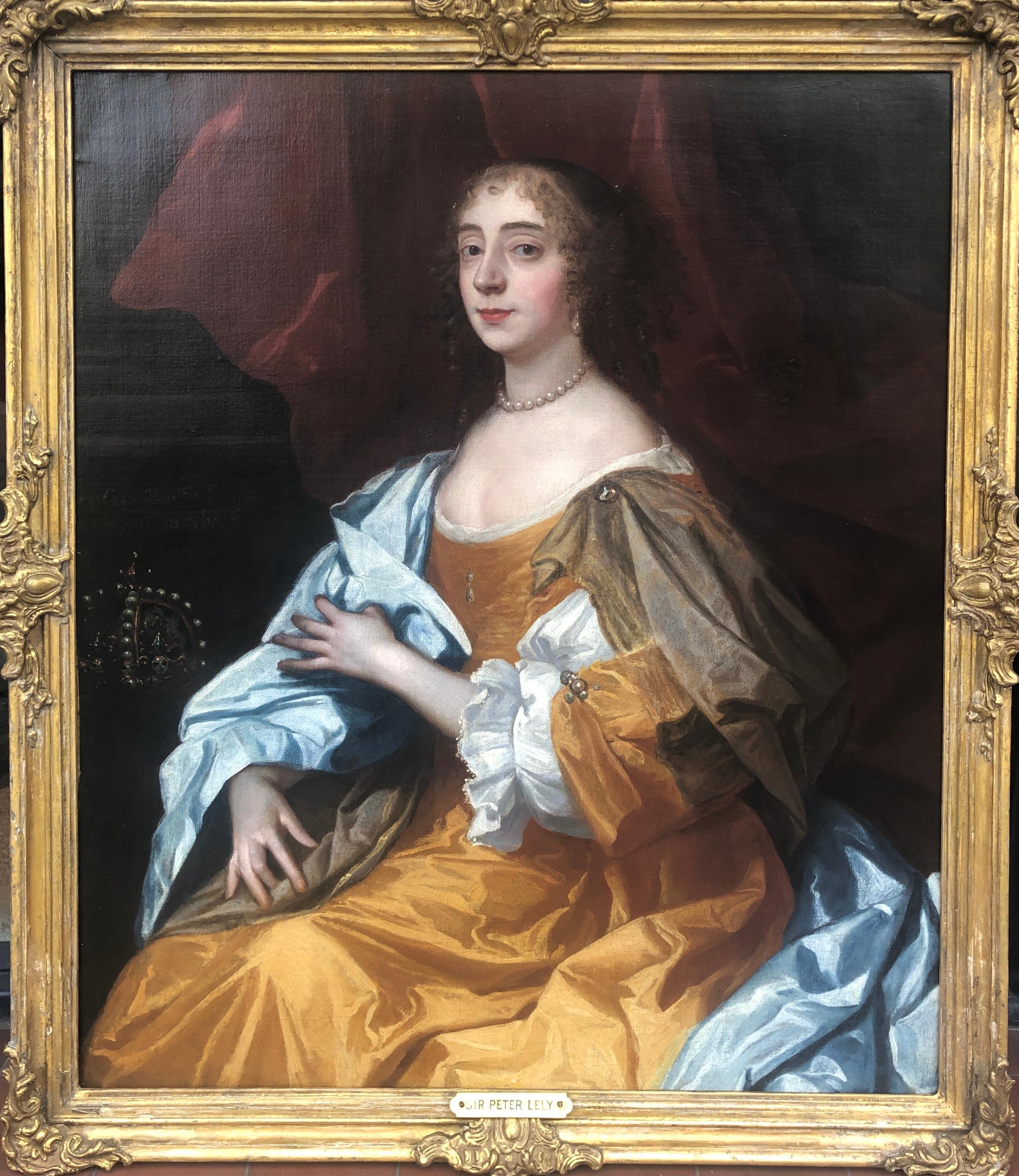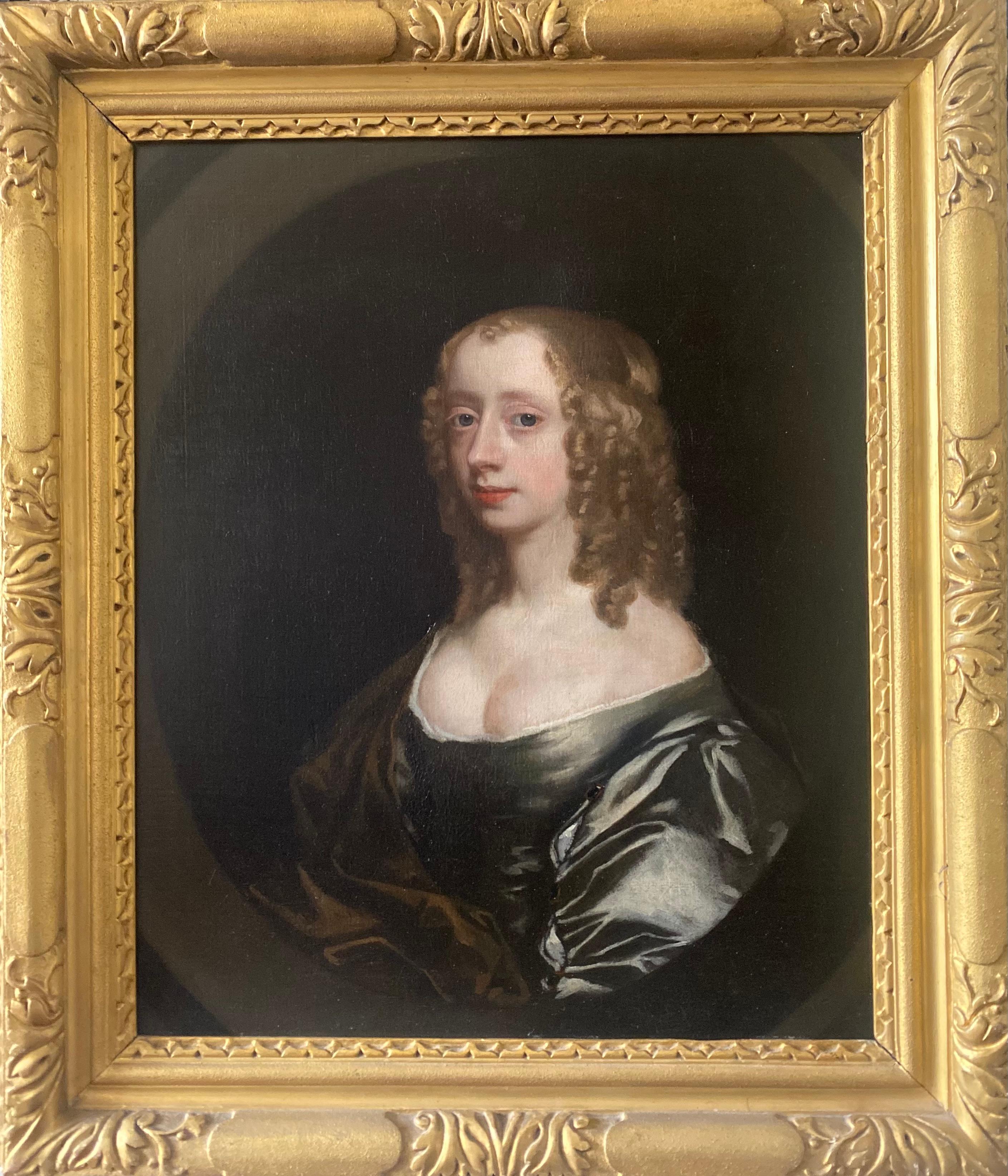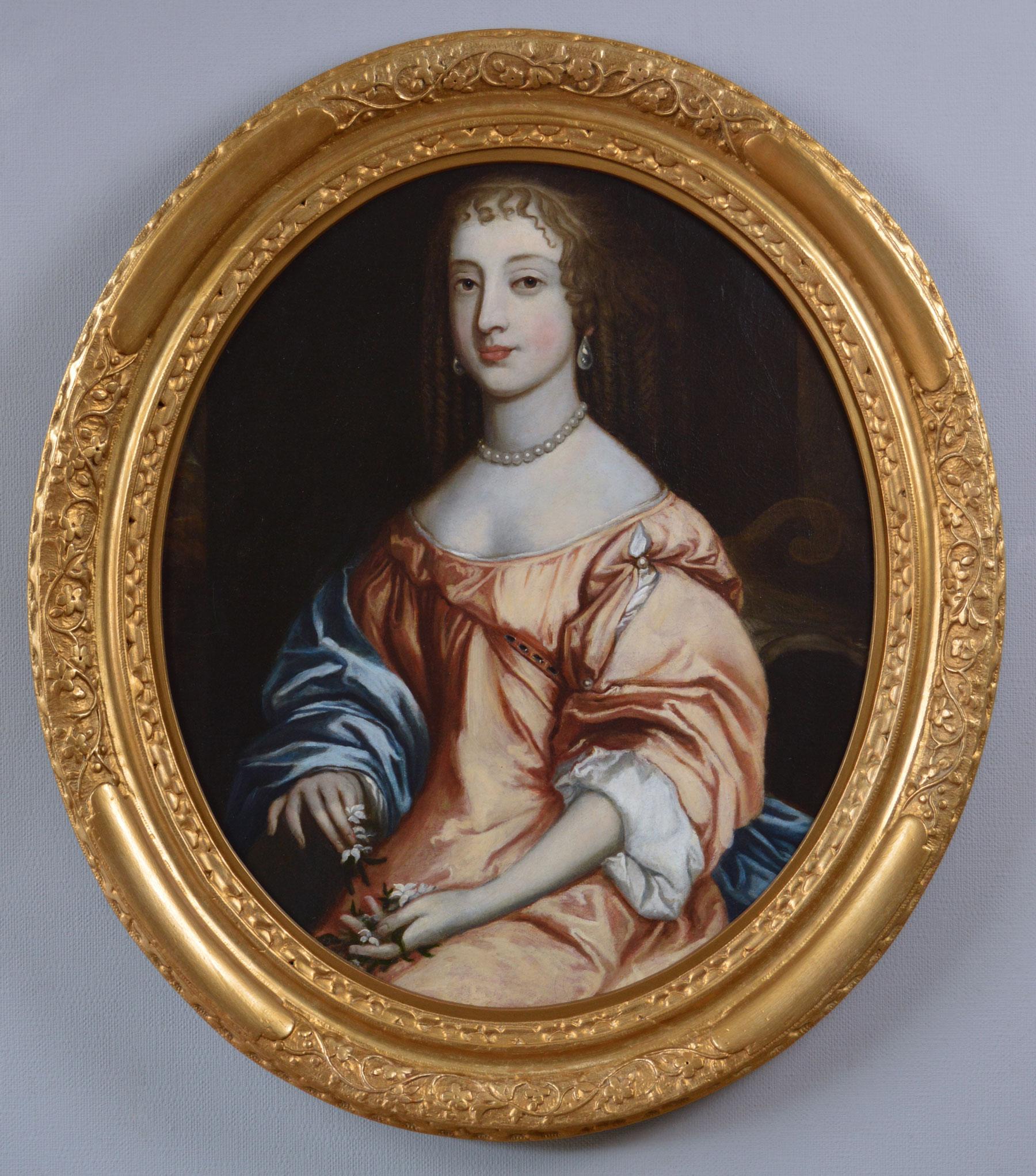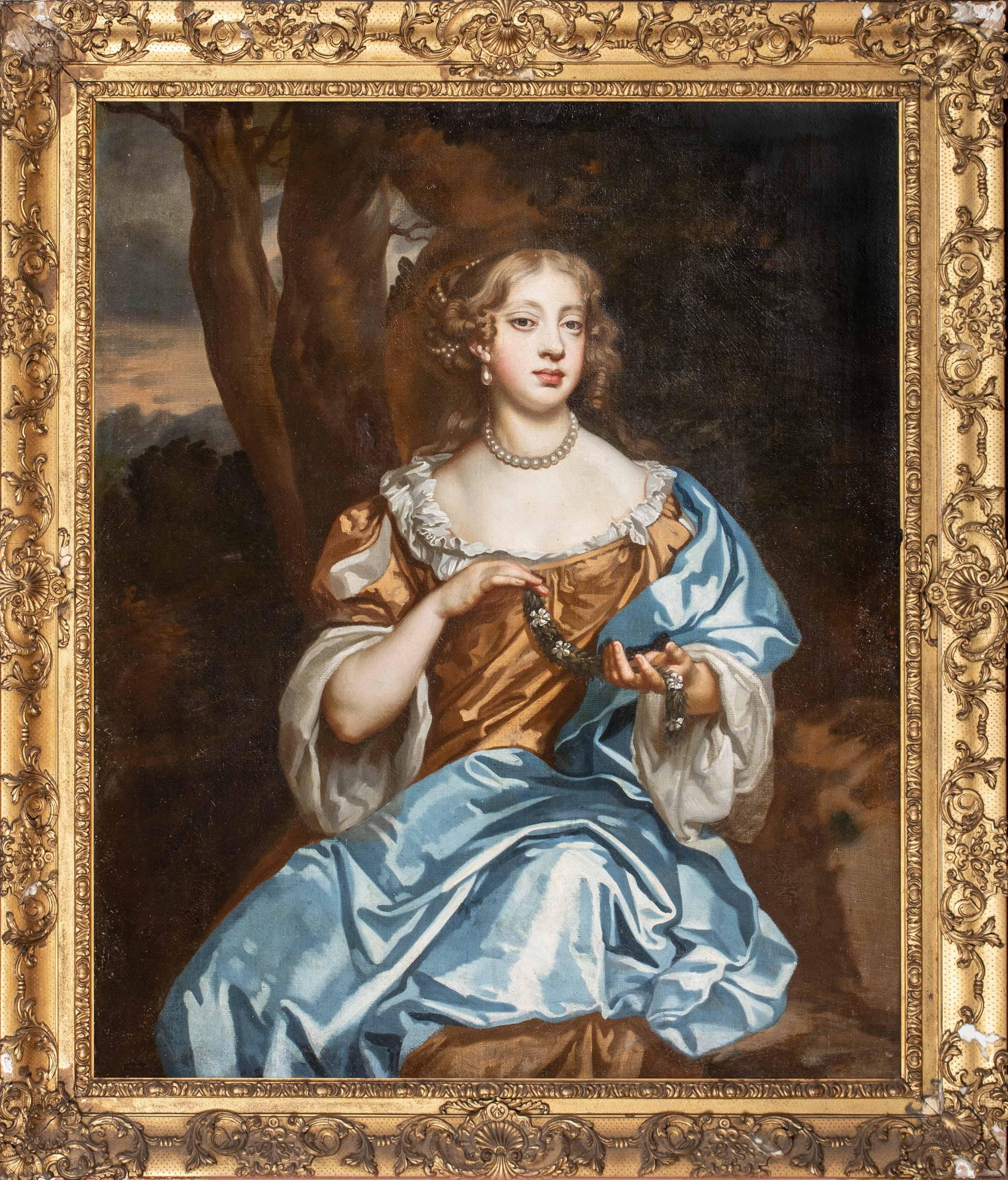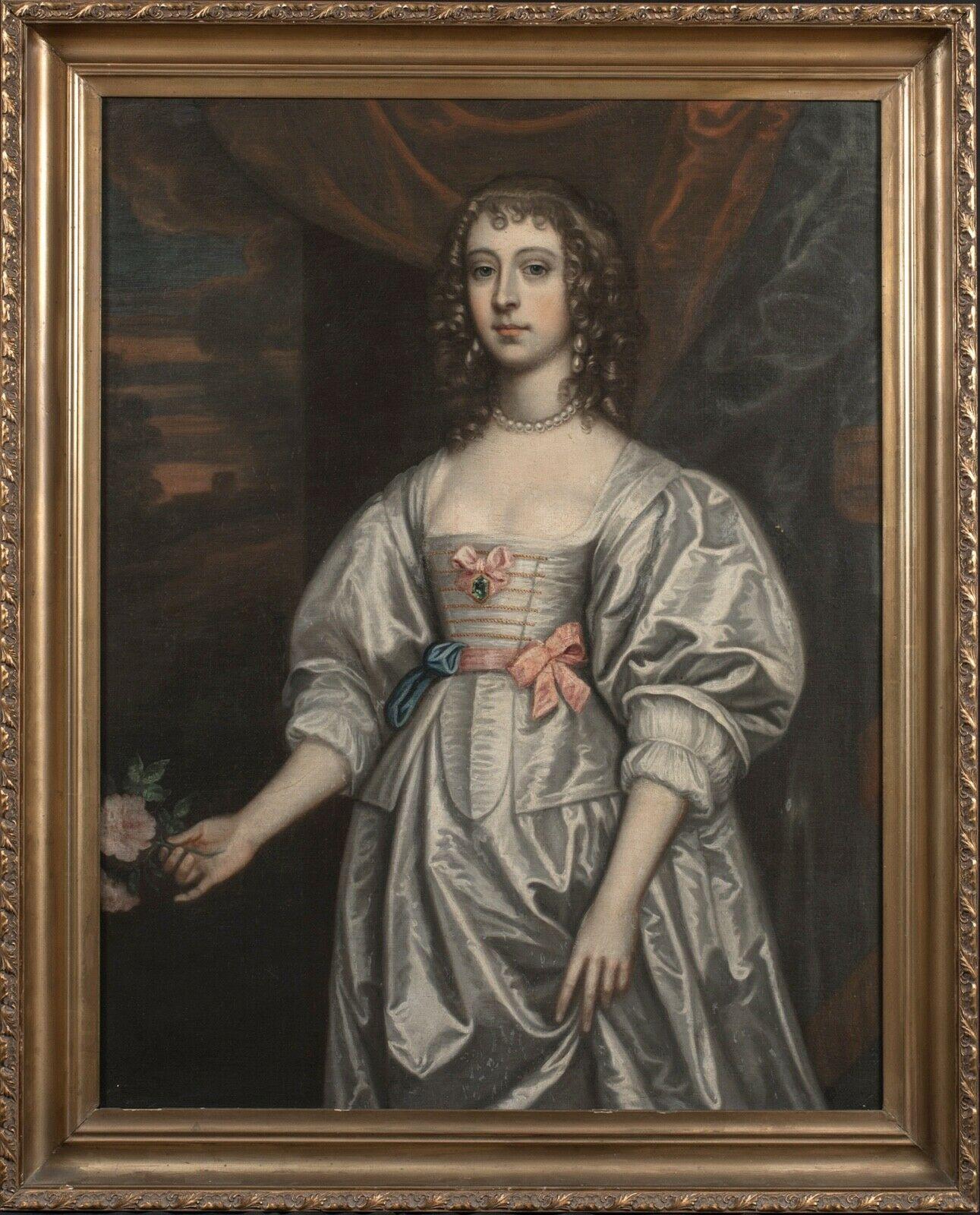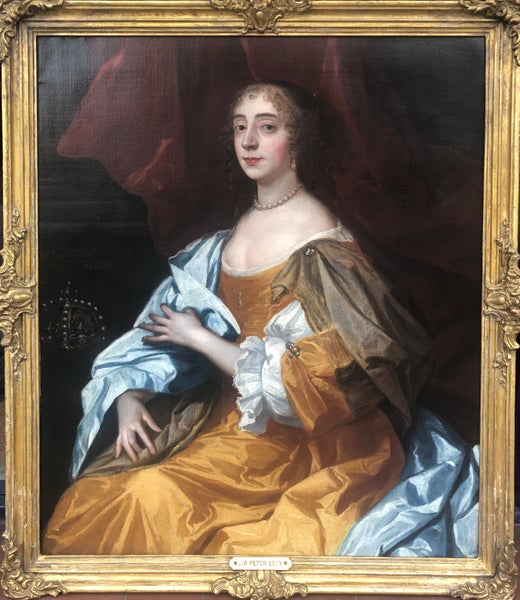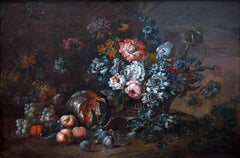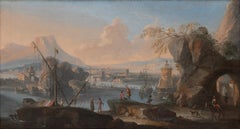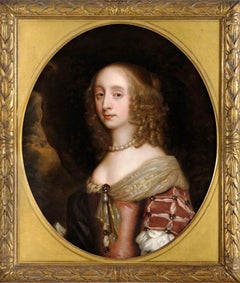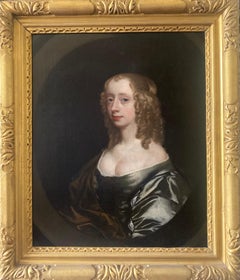Items Similar to Portrait of Barbara Palmer 1st Duchess of Cleveland
Want more images or videos?
Request additional images or videos from the seller
1 of 9
Sir Peter LelyPortrait of Barbara Palmer 1st Duchess of Cleveland
$34,328.04
£25,000
€29,259.23
CA$47,357.93
A$52,059.40
CHF 27,360.03
MX$632,190.69
NOK 341,309.51
SEK 323,366.76
DKK 218,369.03
About the Item
Portrait of Barbara Palmer 1st Duchess of Cleveland 1640-1709, half-length wearing a red dress and portrayed within a cartouche.
Circa 1680
Oil On Canvas
28 x 21 in 70.56 x 52.92 cm
PROVENANCE
From an Italian private collection
ABOUT THE ARTIST
The Dutch artist Peter Lely was trained in Haarlem and came to London in the 1640s. In the early part of his career, he painted Biblical and mythological scenes, but it was as a portraitist that he established his reputation, and he worked throughout the civil wars and Interregnum, becoming the dominant portrait painter to the court.
At the Restoration he was appointed Principal Painter to King Charles II and he was knighted in 1680. By far the most fashionable and influential painter of his time, he also formed a celebrated collection of paintings and drawings. Samuel Pepys called him ‘a mighty proud man, and full of state’.
ABOUT THE SUBJECT
Barbara Villiers was Charles II’s principal mistress between 1660 and 1670 and the most powerful woman at court until she was supplanted by Louise de Kéroualle. The daughter of the Royalist William Villiers, 2nd Viscount Grandison (1614–43), she married Roger Palmer (1634–1705) in 1659; she was granted the title of Countess of Castlemaine in 1661 (entailing the ennoblement of her cuckolded husband Roger Palmer as Earl of Castlemaine) and was elevated to Duchess of Cleveland in her own right in 1670.
After a public disagreement between Charles and Catherine of Braganza in 1662, Lady Castlemaine was made a Lady of the Bedchamber to the queen, and given a pension and lodgings at Whitehall Palace. Between 1660 and 1665 she bore the king five children, all of whom received titles, and though she did not achieve official recognition as maîtresse en titre like the powerful mistresses of French monarchs, her position allowed her to act as an intermediary and negotiate for patronage and benefits on behalf of others.
She devoted much energy to public demonstrations of her hold on the king’s favour, through displays of jewels and wealth and her frequent appearances at court balls and entertainments. Pepys observed in 1663, ‘this day I was told that my Lady Castlemaine hath all the King’s Christmas presents, made him by the peers, given to her .. at the great ball she was much richer in jewels than the Queen and Duchess put together’.
During the 1660s Lady Castlemaine served as the muse of the king’s painter, Sir Peter Lely. She appeared in many paintings by Lely represent as historical or biblical figures but also throughout her life as studio portraits. She was fully aware of the importance of images as promotional tools and Ley was happy to represent ‘her sweetness and exquisite beauty’. We imagine she is near 40 in this portrait.
- Creator:Sir Peter Lely (1618 - 1680, Dutch)
- Dimensions:Height: 28 in (71.12 cm)Width: 21 in (53.34 cm)
- Medium:
- Period:
- Condition:
- Gallery Location:Taunton, GB
- Reference Number:Seller: EFA00081stDibs: LU2028210512062
Sir Peter Lely
Sir Peter Lely (1618-1680) was born in Germany at Soest in Westphalia in 1618. Though his family name was van der Faes, he assumed the name Lely after the lily that was carved on the gable of his father’s home in The Hague. He moved to England in 1641, the year that Van Dyck died, and succeeded Van Dyck. He was court painter to Kind Charles I and King Charles II. By working for many of the patrons of the late van Dyck, Lely rapidly established himself as one of the country’s most important portrait painters.
About the Seller
No Reviews Yet
Vetted Professional Seller
Every seller passes strict standards for authenticity and reliability
Established in 1953
1stDibs seller since 2022
- ShippingRetrieving quote...Shipping from: Taunton, United Kingdom
- Return Policy
Authenticity Guarantee
In the unlikely event there’s an issue with an item’s authenticity, contact us within 1 year for a full refund. DetailsMoney-Back Guarantee
If your item is not as described, is damaged in transit, or does not arrive, contact us within 7 days for a full refund. Details24-Hour Cancellation
You have a 24-hour grace period in which to reconsider your purchase, with no questions asked.Vetted Professional Sellers
Our world-class sellers must adhere to strict standards for service and quality, maintaining the integrity of our listings.Price-Match Guarantee
If you find that a seller listed the same item for a lower price elsewhere, we’ll match it.Trusted Global Delivery
Our best-in-class carrier network provides specialized shipping options worldwide, including custom delivery.More From This Seller
View AllPortrait of a Girl holding a Posy
Located in Taunton, GB
Portrait of a Girl holding a Posy.
Oil on Panel
17 1/2 x 13 inches
44.4 x 33 cm
ABOUT THE ARTIST:
Jacques d'Agar was a French portrait painter born i...
Category
17th Century Romantic Portrait Paintings
Materials
Oil
Still life of Summer Flowers in a Basket with Fruit.
By Pieter Casteels III
Located in Taunton, GB
Still life of Summer Flowers in a Basket with Fruit.
Circa 1730
Oil On Canvas
32 ¾ x 48 ¼ inches83.1 x 122.5 cm
Presented in a 17th century Italian carved gilt frame.
Acquired from The collection of the Late Edgar Wigan, Bradstone Brook, Shalford.
ABOUT THE ARTIST:
The son of the Flemish painter Pieter Casteels II (referred to as Casteels the Younger) whom he studied under. While Casteels II was best known for his capriccio harbour scenes and landscapes of his native Antwerp, Casteels III worked primarily in England, where he immigrated in 1708 at the age of 24 and began his career copying Old Master.
Casteels III painted still lives of flowers, and bird and game scenes, and in 1726 produced a volume of twelve plates of bird etchings. Following the success of the publication, he created similar volumes for both flowers and fruit. Pieter Casteels III...
Category
17th Century Flemish School Still-life Paintings
Materials
Oil
A Mediterranean harbour scene in a Capriccio landscape
By Adriaen van der Cabel
Located in Taunton, GB
A Mediterranean harbour scene with figures and ships before a Capriccio landscape.
Oil on Canvas
In a gilded frame
10 ½ x 19 ½ inches
26.6 x 49.5 cm
ABOUT THE ARTIST:
Adriaen van d...
Category
17th Century Landscape Paintings
Materials
Oil
You May Also Like
17th century English portrait of a lady
By Sir Peter Lely
Located in Bath, Somerset
Miss Ada Gossett, circa 1673, half-length in a landscape at dusk, wearing an amber silk gown adorned with a gold trimmed gauze shawl and fine jewels, wearing a pearl necklace, her fa...
Category
17th Century Old Masters Portrait Paintings
Materials
Canvas, Oil
Portrait of Bridget Drury Lady Shaw, formerly Viscountess Kilmorey
By Sir Peter Lely
Located in London, GB
Sir Peter Lely (Soest 1618 – 1680 London)
Portrait of lady with a crown, possibly Bridget Drury Lady Shaw, formerly Viscountess Kilmorey, later Lady Baber (d.1696) c.1665
Oil on canvas
46 1/2 x 40 3/4 inches, Framed
42 1/4 x 36 1/4 inches, Unframed
Inscribed left [……….]Isabella
James Mulraine wrote the following for this piece:
This portrait dates to the middle of the 1660s, the decade when Lely’s career took off as successor to Sir Anthony van Dyck. At the Restoration Charles II had appointed him Principal Painter to the King and paid a pension £200 per annum ‘as formerly to Sr. Vandyke...’1 Lely had trained in Haarlem and he was in his early twenties when he came to London in 1643. He was an astute businessman and a wise courtier. In 1650 he painted a portrait of Oliver Cromwell (Birmingham Museum and Art Gallery) while maintaining links with the Royalist exiles through the 1650s. He had arrived in England as a painter of small-scale portraits and lush scenes of nymphs in landscapes in a Dutch style. His experience of Van Dyck in English collections transformed his painting. His lavish and alluring vision of Arcadia exactly captured the spirit of the Court and as Principal Painter he dominated English portraiture for the next twenty years. Lely ran a highly efficient studio along Netherlandish lines, employing a team of specialists like the drapery painter John Baptist Gaspars and young artists-in-training like Nicolas de Largilliere. He had numerous rivals during that period, and by 1670 he had introduced numbered standard poses to speed up production, while collaborating with printmakers for further revenue and advertising. He died in 1680 of a stroke while painting, working to the last.
The portrait, painted at a date when Lely’s poses and execution were still individual and inventive shows a lady sitting at three-quarter length facing away from the viewer. She has begun to turn towards the viewer, a pose with a long pedigree in art, first used by Leonardo da Vinci in the Mona Lisa (Louvre). She steadies her blue drapery where it might slip from her arm with the movement, a flash of realism beautifully captured. Like Van Dyck, Lely painted his female sitters in a timeless costume rather than contemporary fashion, showing a loose gown and floating silk draperies. It presented the sitter as a classical ideal. The portrait would not date.
The saffron dress may be the work of a drapery painter but the brown scarf must be by Lely himself, and appears unfinished, broadly sketched in behind the shoulder. The delicate blue glaze and nervous highlights suggest shimmering translucence. Lely was a master of painting hands – his hand studies are marvels of drawing – and the lady’s hands are superb, exactly drawn, delicately modelled and expressive. The fidgety gestures, clutching the gown, fiddling with the edge of the scarf, give the portrait psychological bite, suggesting the personality behind the calm courtier’s expression, adding to the sense shown in the look of the eyes and mouth that the lady is about to speak. The portrait’s language is Vandykian. The inspiration comes directly from Van Dyck’s English portraits of women. Lely owned Van Dyck’s Portrait of Lady Elizabeth Thimbleby and Dorothy Viscountess Andover (National Gallery, London) and the sitter’s costume quotes Lady Andover’s saffron dress and brown scarf. But Lely paints a generation who sat nearer to the ground and through a dialogue of expression and gesture he shows sitters who are more flesh and blood than Van Dyck’s.
The background with a column and curtain is different to those shown in most of Lely’s portraits of women. They tend to include trees or fountains, with a glimpse of landscape. But there are other examples. A portrait of the King’s reigning mistress, Barbara Villiers Duchess of Cleveland...
Category
1660s Portrait Paintings
Materials
Oil
$71,402 Sale Price
20% Off
Free Shipping
English 17th century portrait of a lady
By Sir Peter Lely
Located in Bath, Somerset
A 17th century English portrait of a lady by Sir Peter Lely (1618-1680), half-length in a painted feigned oval, wearing a green silk gown with chestnut coloured cloak over one shoulder, her fair hair curled in the fashionable ringlet style of the period. Oil on canvas in an English giltwood 'Lely' frame.
We are grateful to Diana Dethloff and Catharine MacLeod (who are currently working on a Lely catalogue raisonné) for their confirmation of Lely as the artist from photograph analysis of this previously unidentified early work.
Provenance:
Private collection Nottingham until 2021
Mellors and Kirk sale December 2000, lot 1173
The sitter is likely to have been from an upper class or aristocratic family in court circles, who were the main source of Lely`s patronage. The simple composition serves to highlight the beauty of the sitter through portraying her pale decolletage and complexion, set against the gentle gaze of her blue eyes, the soft blush of her cheeks and her full red lips.
Peter Lely (1618-1680) was originally of dutch origin and became Principle Painter to the King in 1661, following in the footsteps of Van Dyck who had died in 1641. He dominated the portrait painting scene in England for over 20 years, creating a distinctive 'court look' in his work which had a strong influence on many other artists. He had an extremely successful and popular portrait practice which meant that he soon had to develop production methods that could accommodate the high demand for portraits, and also for copies and versions of them which were given as gifts to family and courtiers. The use of studio assistants was a common practice for busy artists and as with Van Dyck, Lely is known to have used specialist assistants to execute particular parts of his paintings. Artists who worked in Lely`s studio included John Baptist Gaspars who specialised in drapery painting, William Wissing, John Greenhill...
Category
17th Century Baroque Portrait Paintings
Materials
Canvas, Oil
$24,166 Sale Price
20% Off
17th Century portrait oil painting of a lady
Located in Nr Broadway, Worcestershire
Circle of Sir Peter Lely
Dutch, (1618-1680)
Portrait of a Lady, traditionally identified as Princess Henrietta Anne Stuart
Oil on canvas
Image...
Category
17th Century Portrait Paintings
Materials
Canvas, Oil
Portrait Of Letitia, later Lady Russell (c.1645–1721), 17th Century
By Studio of Sir Peter Lely
Located in Blackwater, GB
Portrait Of Letitia, later Lady Russell (c.1645–1721), 17th Century
Studio of Sir Peter Lely (1618-1680)
Huge 17th Century three quarter length portrait of Letitia later Lady Russe...
Category
17th Century Portrait Paintings
Materials
Canvas, Oil
Portrait Of A Lady, Frances Bard (1646-1702) Mistress of The Duke Of Cumberland
By Anthony van Dyck
Located in Blackwater, GB
Portrait Of A Lady, Frances Bard (1646-1702) Mistress of Prince Rupert von de Pfalz, Duke of Cumberland (1619-1882)
follower of Anthony Van Dyck (1...
Category
Late 17th Century Old Masters Portrait Paintings
Materials
Oil
More Ways To Browse
Antique Duchess
17th Century Dutch Portrait Oil Paintings
Full Length Portrait Oil Painting
Charles Knight
Portrait Duchess
Sir Peter Lely
King Charles Ii
Catherine Of Braganza
Whitehall Palace
17th And 18th Century Portraits
1920 Oil Portraits
Antique Family Portraits
Russia Portrait
Gentleman Oil Portrait
Gilt Framed Woman Portrait Oil Paintings
16th Century Portrait Oil Paintings
Portrait Of A Woman Reading
Painted Portrait Girl In Pink

